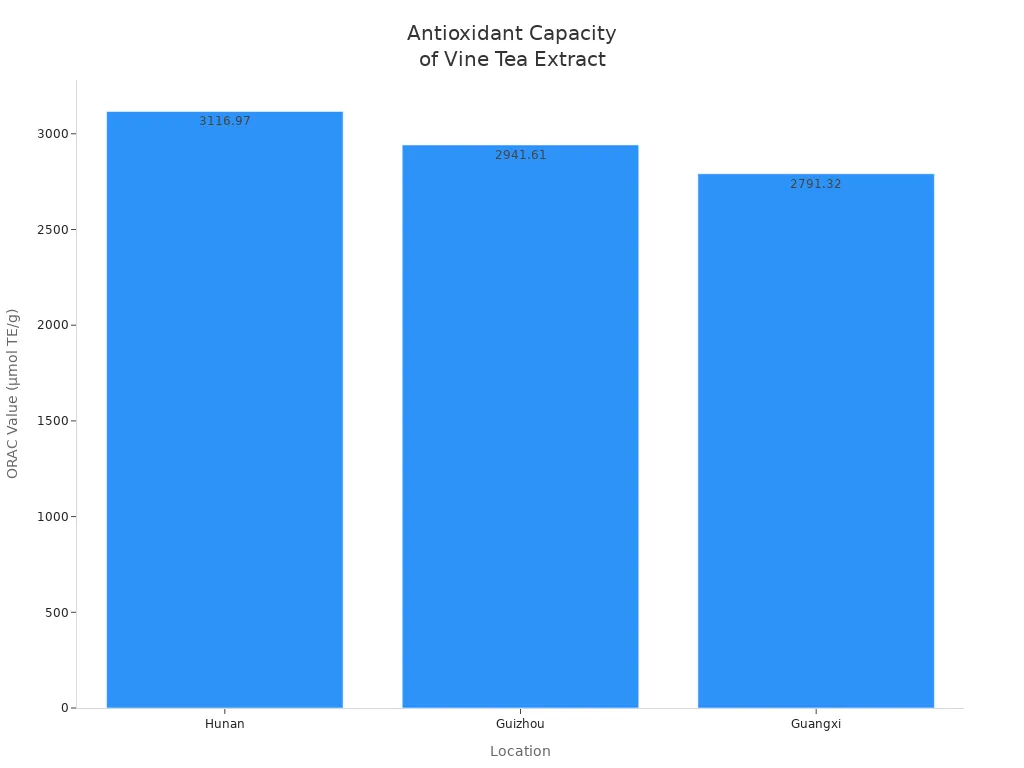T: +86-731-89865681
E: info@kingherbs.com
E: info@kingherbs.com
27Fl, Blding A, Cimen Fun City, Wanjiali Road, Changsha 410014, Hunan, China
Views: 0 Author: Site Editor Publish Time: 2025-09-12 Origin: Site
Vine tea extract dihydromyricetin comes from the leaves and stems of Ampelopsis grossedentata, a plant known as vine tea. You find this dihydromyricetin extract used widely for its health benefits. Many industries choose vine tea extract for its antibacterial effects, especially in food safety. Dihydromyricetin and myricetin work together to support metabolic health and help regulate alcohol metabolism. You see this extract in products that improve wellness, preserve food, and care for your skin.

You encounter vine tea extract dihydromyricetin as a refined powder sourced from the leaves and stems of Ampelopsis grossedentata, a climbing plant native to China. This extract contains dihydromyricetin, a flavonoid also known as Ampelopsin. Chemists identify dihydromyricetin by its CAS number 27200-12-0 and molecular formula C15H12O8. You recognize it by its white to off-white appearance and its ability to dissolve in hot water. Manufacturers value dihydromyricetin for its purity and stability, making it a preferred choice for health, food, and cosmetic products.
| Property | Value |
|---|---|
| Botanical Source | Ampelopsis grossedentata |
| CAS Number | 27200-12-0 |
| Molecular Formula | C15H12O8 |
| Appearance | White to off white powder |
| Solubility | Soluble in hot water |
| Molecular Weight | 320.25100 |
You find dihydromyricetin in vine tea extract, which stands out for its bioactive properties. This compound supports liver health, regulates metabolism, and protects cells from oxidative stress. You see it used in supplements, functional foods, and skincare products.
You discover that vine tea has a rich history in traditional Chinese medicine. Nearly 700 years ago, the text Yin Shan Zheng Yao documented the consumption and benefits of Ampelopsis grossedentata. During the Qing Dynasty, local pharmaceutical texts such as Caomu Bianfang included this plant for its medicinal value. After 1949, herbal compendiums continued to recognize vine tea for its therapeutic uses.
| Year | Document/Source | Description |
|---|---|---|
| 694 years ago | Yin Shan Zheng Yao | First historical record of consumption and efficacy of Ampelopsis grossedentata. |
| Mid Qing Dynasty | Caomu Bianfang | Included Ampelopsis grossedentata in local pharmaceutical texts. |
| Post-1949 | Herbal compendiums | Listed in multiple Chinese herbal medicine references. |
You see that the use of dihydromyricetin from vine tea extract reflects centuries of trust and scientific validation. Today, you benefit from this legacy through modern applications in wellness and nutrition.
You encounter dihydromyricetin as a standout molecule among flavonoids. This compound features a unique structure with multiple hydroxyl groups, which allow it to interact with free radicals and neutralize them. The molecular formula, C15H12O8, gives dihydromyricetin its remarkable antioxidant properties. You notice that manufacturers extract dihydromyricetin from Ampelopsis grossedentata using advanced techniques to preserve its purity. The extract contains bioactive compounds that support your health and wellness goals. You see dihydromyricetin in a fine powder form, which dissolves easily in hot water and maintains stability in various formulations. The presence of these hydroxyl groups enhances its antioxidant activity, making it a preferred choice for products that target oxidative stress.
You benefit from dihydromyricetin’s diverse bioactive effects. This compound acts as a powerful antioxidant, helping you combat oxidative stress and protect your cells from damage. You find that dihydromyricetin can reduce oxidative stress by scavenging free radicals and lowering harmful compounds like malondialdehyde. The antioxidant activity of dihydromyricetin surpasses many other natural ingredients, making it valuable in food preservation and skin care. You also experience antimicrobial benefits, as dihydromyricetin inhibits bacteria such as Staphylococcus aureus. Researchers have validated its anti-inflammatory effects, which help you manage inflammation and maintain overall health. Dihydromyricetin supports metabolic balance, assisting you in regulating blood sugar and improving insulin sensitivity. You may also notice neuroprotective and anticancer properties, which add to its appeal in advanced health products. Scientists have found that dihydromyricetin can modulate the tlr4/myd88/nf-κb pathway, further enhancing its ability to reduce oxidative stress and inflammation.
You can review the table below to see the range of bioactive properties associated with dihydromyricetin:
| Bioactive Property | Description |
|---|---|
| Antioxidant | Dihydromyricetin (DMY) is recognized for its ability to scavenge free radicals and reduce oxidative stress. |
| Antimicrobial | Exhibits antibacterial activity against Gram-positive bacteria, specifically Staphylococcus aureus. |
| Anti-inflammatory | Demonstrates properties that help reduce inflammation in various biological contexts. |
| Anticancer | Shows potential therapeutic benefits in the treatment of cancer. |
| Antidiabetic | May assist in managing blood sugar levels and improving insulin sensitivity. |
| Neuroprotective | Provides protective effects on neuronal cells, potentially aiding in neurodegenerative conditions. |
| Anti-HIV | Proven to inhibit HIV-1 by down-regulating CXCR4 on target cells. |
You see that dihydromyricetin’s ability to address oxidative stress, inflammation, and metabolic challenges makes it a versatile ingredient for your health and wellness needs.

You gain significant liver protection when you use vine tea extract dihydromyricetin. This dihydromyricetin extract supports your liver by reducing oxidative stress and inflammation. You benefit from its ability to enhance ethanol metabolism, which helps your body process alcohol more efficiently. Dihydromyricetin increases the activity of enzymes like ADH and ALDH, breaking down alcohol and its toxic byproducts. You experience less liver damage and a lower risk of fatty liver disease.
Researchers have explored the therapeutic effects of dihydromyricetin on liver health. The table below summarizes key findings:
| Study | Findings |
|---|---|
| Zhang et al. (2017) | Down-regulates the Akt/Bad pathway in HepG2 cells, reducing apoptosis. |
| Dong et al. (2019) | Counters acetaminophen-induced liver injury by modulating lipid homeostasis and cell death. |
| Zeng et al. (2020) | Improves non-alcoholic steatohepatitis, showing a protective effect. |
You see that dihydromyricetin not only supports alcohol metabolism but also protects your liver from oxidative stress and inflammation. The bioactive compounds in vine tea extract help maintain healthy liver function and reduce the risk of chronic liver conditions.
| Mechanism | Findings |
|---|---|
| Enhanced Ethanol Metabolism | Increases ADH and ALDH activity, improving ethanol breakdown in the liver. |
| Reduction of Alcohol-Induced Injury | Reduces lipid accumulation and inflammatory responses caused by alcohol. |
| Hepatoprotection | Maintains hepatocellular bioenergetics and reduces oxidative stress. |
You benefit from the metabolic regulation provided by dihydromyricetin. This compound helps you manage blood glucose levels and supports insulin sensitivity. Dihydromyricetin and myricetin work together to lower blood lipids and reduce insulin resistance. You experience improved metabolic health and a lower risk of metabolic syndrome.
| Evidence Type | Findings |
|---|---|
| Glucose Regulation | Regulates glucose in T2DM mice, enhances insulin sensitivity, and alleviates metabolic syndrome. |
| Lipid Metabolism | Lowers blood lipid levels and reduces lipid accumulation linked to insulin resistance. |
| Molecular Mechanism | Modulates phosphorylation of insulin receptor substrate-1 and SREBP-1c, reducing triglycerides. |
| Antioxidant Effects | Restores antioxidant enzyme system and reduces liver lipid peroxidation, improving oxidative stress. |
| Glycolysis and TCA Cycle | Reverses glycolytic alterations, decreases glycolytic intermediates in the liver. |
| Inhibition of Gluconeogenesis | Inhibits gluconeogenesis via the Akt/FoxO1/PCK2 pathway. |
You notice that dihydromyricetin offers unique pharmacological effects compared to other glucose regulators. Unlike some antidiabetic agents, dihydromyricetin provides both antioxidant and anti-inflammatory activity. You receive comprehensive metabolic support, including improved insulin function and reduced oxidative stress.
Dihydromyricetin stands out for its antioxidant properties. You benefit from its ability to neutralize free radicals and reduce oxidative stress. The antioxidant activity of this bioactive compound surpasses many other natural antioxidants.
| Location | ORAC Value (μmol TE/g) |
|---|---|
| Hunan | 3116.97 |
| Guizhou | 2941.61 |
| Guangxi | 2791.32 |

You see consistent antioxidant activity across different regions, confirming the stability of dihydromyricetin’s bioactivities. The IC50 for pure dihydromyricetin is 3.24 μg/mL, which demonstrates strong antioxidant capacity. You also benefit from its anti-inflammatory and anti-tumor effects, as well as neuroprotective and antidiabetic properties.
You find that the antioxidant superiority of dihydromyricetin makes it valuable for food preservation. Its ability to combat oxidative stress extends shelf life and maintains food quality. You can rely on vine tea extract to deliver both health benefits and functional advantages in food and beverage products.
You can find dihydromyricetin in a wide range of functional foods and beverages. Manufacturers use this ingredient to create products that support your energy and well-being. Vine tea extract dihydromyricetin appears in anti-fatigue drinks and traditional health teas. These products help you stay alert and refreshed throughout the day. In China, food safety standards allow the use of vine tea as a raw material in many beverage formulas. The table below shows common applications:
| Application | Description |
|---|---|
| Anti-Fatigue Beverages | Used to craft drinks that help reduce tiredness and boost stamina. |
| Traditional Health Tea | Enjoyed for centuries in China, now featured in modern functional foods. |
| Raw Material in Beverages | Meets food safety standards, making it a trusted choice for beverage manufacturers. |
You may notice a slightly bitter taste in some drinks, but many brands balance this with natural flavors.
You benefit from dihydromyricetin in several supplement formats. Capsules, tablets, and powders deliver targeted support for your liver, metabolism, and antioxidant needs. When you take these supplements, you may experience:
Higher levels of superoxide dismutase (T-SOD) and glutathione (GSH), which protect your cells.
Increased muscle catalase (CAT) and HDL cholesterol, supporting heart and muscle health.
Lower malondialdehyde (MDA) and triglycerides, reducing oxidative stress and fat buildup.
Activation of Nrf2 and AMPK/ACC pathways, which help your body manage energy and fat.
Enhanced production of alcohol-metabolizing enzymes like ADH and ALDH, improving alcohol breakdown.
Reduced liver fat and inflammation.
You can choose from capsules, tablets, powders, and even instant tea sachets. The table below highlights popular product formats:
| Product Format | Applications |
|---|---|
| Capsules/Tablets | Liver detox, hangover relief, metabolic support |
| Powders | Antioxidant blends, pre-workout or recovery formulas |
| Tea Products | Herbal tea sachets, detox drinks |
| Food Enhancers | Energy bars, gummies, functional chocolates |
You can enhance your skincare routine with dihydromyricetin. This ingredient offers strong antioxidant protection, helping your skin fight free radicals and signs of aging.
Studies show that vine tea extract dihydromyricetin provides powerful antioxidant effects. These benefits support skin health and anti-aging by neutralizing free radicals and activating cellular pathways that protect your skin.
You will appreciate that dihydromyricetin is gentle on your skin. Unlike some active ingredients that may cause redness or discomfort, this compound suits sensitive skin types. You can use products with vine tea extract dihydromyricetin daily for a soothing and effective skincare experience.
You see a dynamic market for vine tea extract dihydromyricetin, with several suppliers offering a range of product grades. You can select pharmacy, food, or cosmetic grade extracts depending on your application. The table below highlights leading suppliers and their available grades:
| Supplier | Product Grade | Content | Packaging |
|---|---|---|---|
| Echemi | Pharmacy Grade | 99% | 25KG/Drum |
| Echemi | Food Grade | 98% | 25kg/drum |
| Staherb Factory | Food Grade | 98% | 1kg/aluminium foil bag; 25kg/Cardboard Drum |
| Heaven | Food Grade, Cosmetic, Medicine | 99% | 1kg, 25kg |
| Senwayer | Pharmacy Grade | 99% | 1kg/bag |
| Dideu | Pharmacy Grade | 99% | 25kg/Cardboard Drum |
You notice that high-purity dihydromyricetin is available for pharmaceutical and food applications. This flexibility allows you to choose the best grade for your needs, whether you focus on glucose management, insulin support, or antioxidant protection.
You benefit from advanced extraction methods that prioritize sustainability and purity. Manufacturers use several techniques to maximize yield and minimize environmental impact:
Chelating extraction increases yield and purity, reducing oxidation during processing.
Microwave-assisted multistage countercurrent extraction breaks down plant cells efficiently, using water as the solvent.
Soxhlet extraction and recrystallization rely on organic solvents and purification steps to achieve high-purity dihydromyricetin.
These methods help you access extracts that support blood glucose levels, reduce insulin resistance, and maintain consistent quality.
You gain significant advantages when you choose dihydromyricetin for product development. This compound dissolves easily in water, making it ideal for functional beverages and supplements. You can incorporate it into capsules, powders, teas, and even skincare products. Its stability ensures that you deliver consistent results, whether you target glucose regulation or insulin enhancement.
You stand out in the beverage market by using dihydromyricetin. Its water solubility and high purity allow you to create drinks that support glucose metabolism and insulin sensitivity. You meet consumer demand for natural, antioxidant-rich products. Market reports show that the vine tea extract market will grow at a CAGR of 8.3% from 2024 to 2030, reaching USD 2.8 billion. You also see a strong trend toward immunity-boosting and detoxifying beverages. In the United States, the market is projected to grow at a CAGR of 10.8% from 2026 to 2033, driven by rising interest in plant-based health solutions.
You can expect continued growth as consumers seek clean label ingredients and functional drinks that help regulate blood glucose levels and support insulin function.
You gain access to a broad spectrum of pharmacological effects when you choose vine tea extract dihydromyricetin. This compound demonstrates unique mechanisms that set it apart from other botanical ingredients. Dihydromyricetin supports lipid metabolism, regulates bile acids, and enhances glucose uptake. It also provides anti-inflammatory, anti-tumor, antidiabetic, and neuroprotective benefits. The table below highlights several mechanisms identified in scientific research:
| Mechanism of Action | Description |
|---|---|
| Lipid Metabolism | Protects liver function and boosts ethanol metabolism. |
| Bile Acid Regulation | Prevents obesity by modulating bile acid pathways. |
| Oxidative Stress | Improves cognitive function and inhibits acetylcholinesterase. |
| Inflammation | Reduces cardiotoxicity by activating SIRT1 and inhibiting NLRP3 inflammasome. |
| Glucose Uptake | Stimulates GLUT1 translocation and activates AMPK/Akt pathways. |
| Cancer Cell Death | Induces selective ROS-mediated cell death and promotes apoptosis in cancer cells. |
| Cardiovascular Protection | Minimizes myocardial damage and supports heart health through SIRT3/FOXO3a and Nrf2 activation. |
You benefit from the versatility of dihydromyricetin across multiple industries. This compound delivers consistent bioactivities, including antioxidant, antibacterial, and anti-inflammatory actions. You can use vine tea extract dihydromyricetin in food preservation, packaging, supplements, and cosmetics. The table below compares its activities with other botanical extracts:
| Activity Type | Dihydromyricetin (DMY) | Other Botanical Extracts |
|---|---|---|
| Antioxidant | Yes | Varies |
| Antibacterial | Yes | Varies |
| Anti-inflammatory | Yes | Varies |
| Food Preservation | Yes | Limited |
| Packaging Applications | Yes | Limited |
You can rely on dihydromyricetin for therapeutic and functional benefits in diverse product formulations.
You can trust the safety of vine tea extract dihydromyricetin. Toxicological studies show no data indicating acute toxicity, skin irritation, or carcinogenicity. Regulatory agencies in the United States, European Union, United Kingdom, Japan, and India allow dihydromyricetin as a dietary supplement. You see it regulated under standards that protect public health and ensure proper labeling.
In the U.S., dihydromyricetin follows the Dietary Supplement Health and Education Act of 1994 (DSHEA).
In the EU, it meets the Food Supplements Directive (2002/46/EC).
You find no specific bans or restrictions in major markets.
You enjoy peace of mind knowing that vine tea extract dihydromyricetin meets global safety and compliance standards.
You discover a wide range of benefits when you use dihydromyricetin. The table below highlights its major applications:
| Benefit/Application | Description |
|---|---|
| Antioxidant Properties | Helps you fight oxidative stress by neutralizing free radicals. |
| Liver Health Support | Promotes liver protection and aids recovery after alcohol consumption. |
| Weight Management | Supports metabolism and energy, assisting with weight control. |
| Neurological Health | May help manage conditions like Alzheimer's by reducing oxidative damage. |
| Liver Disease Treatment | Reduces inflammation and supports liver disease therapy. |
| Detoxification | Enhances your body's natural detox processes for better liver function. |
Researchers continue to explore new directions, including selenium-modified dihydromyricetin for improved blood glucose regulation and anti-tumor effects. You can expect future studies to clarify its molecular actions and long-term safety.
You typically take 50–200 mg per day, depending on your health goals and product instructions. Always follow the label directions or consult a healthcare professional for personalized advice.
Yes, you can combine it with most vitamins and minerals. However, you should check with your healthcare provider before starting any new supplement routine to ensure safety and avoid interactions.
Most people tolerate this extract well. You may rarely experience mild digestive discomfort. If you notice any unusual symptoms, stop using the product and seek medical advice.
Store the extract in a cool, dry place away from direct sunlight. Keep the container tightly closed to maintain freshness and potency.
Yes, this plant-based extract contains no animal-derived ingredients. You can safely include it in vegetarian and vegan diets.